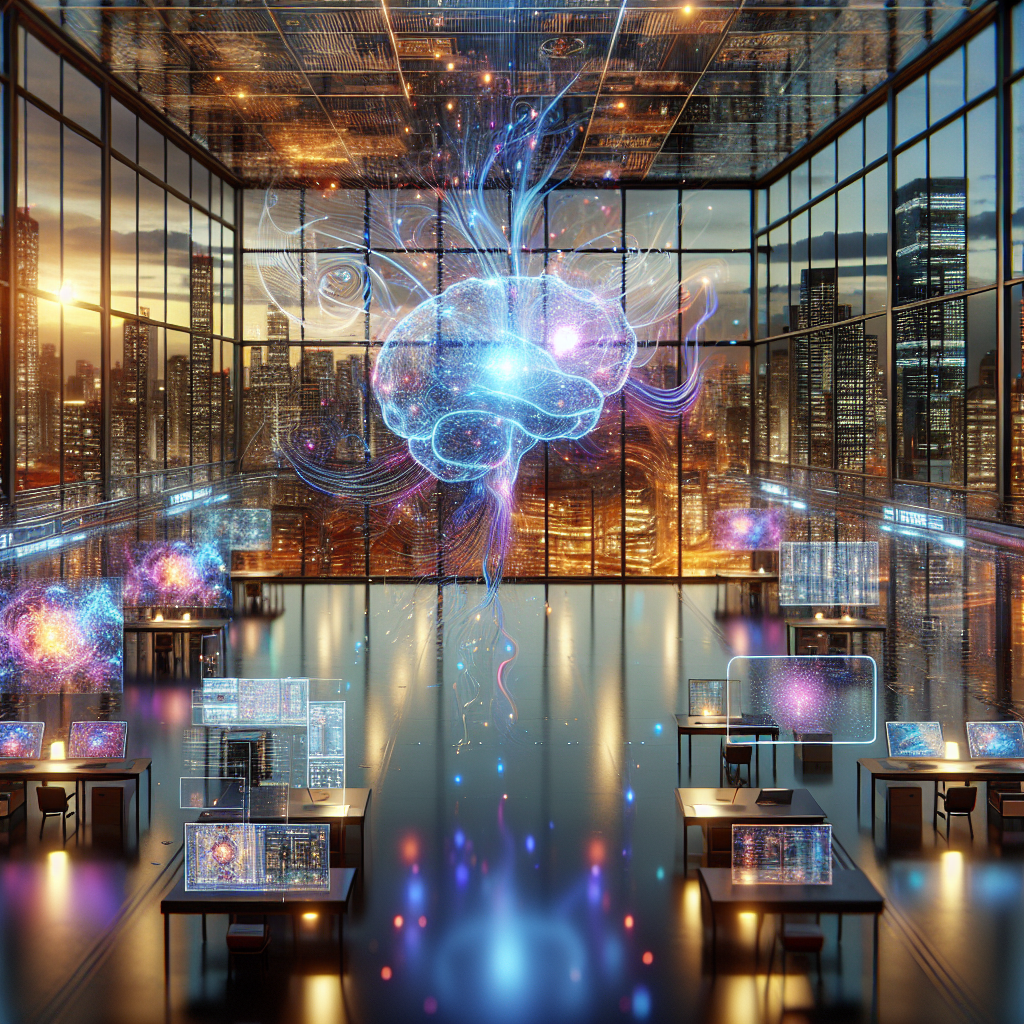Exploring Generative AI’s Impact on Creative Industries

Exploring Generative AI’s Impact on Creative Industries
The advent of generative artificial intelligence (AI) has sparked a revolution across various fields, with creative industries experiencing some of the most profound transformations. From fashion to film, music to visual arts, generative AI applications are redefining creativity and innovation. This blog post delves into the transformative impact of generative AI on creative sectors, examining how artistic innovation is reshaping the landscape.
Introduction
Generative AI refers to a subset of artificial intelligence technologies capable of generating new content by learning from existing data. These applications have become integral in creative processes, providing artists and creators with unprecedented tools for expression and experimentation. As these technologies continue to evolve, they promise not only to enhance human creativity but also to transform the very fabric of creative industries.
In this post, we will explore various facets of generative AI’s impact on creative sectors, examining both opportunities and challenges it presents. We’ll look at how these tools are used in practice and consider their implications for the future of artistic innovation.
The Rise of Generative AI Applications
Generative AI applications have experienced rapid growth over recent years, driven by advancements in machine learning algorithms and increased computational power. These technologies can create text, images, music, and even video content that is often indistinguishable from work produced by humans.
Key Technologies Behind Generative AI
Neural Networks: At the heart of generative AI are neural networks, particularly deep learning models like Generative Adversarial Networks (GANs) and Variational Autoencoders (VAEs). These models learn to mimic patterns in data and generate new content reflecting those learned patterns.
Natural Language Processing (NLP): In text generation, NLP algorithms such as GPT (Generative Pre-trained Transformer), developed by OpenAI, have set new standards for creating coherent and contextually relevant written content.
Style Transfer: This technique involves applying the style of one image to another, widely used in visual arts to create novel artworks with minimal human intervention.
The fusion of technology and creativity leads to groundbreaking developments in design and entertainment. Companies like Adobe are leveraging these advancements to enhance their creative software offerings, empowering artists worldwide.
Transforming Creative Industries
Generative AI applications have become pivotal in transforming creative industries by fostering artistic innovation. By utilizing generative models, creators can produce novel artworks with minimal human intervention, allowing for more experimentation and boundary-pushing ideas.
Fashion Industry
In fashion, generative AI is used to design new clothing patterns, fabrics, and even entire collections. Brands are leveraging these technologies to predict trends and customize designs based on consumer preferences. For example, companies like Zalando use AI to create personalized shopping experiences by recommending outfits that match a customer’s style.
Film and Entertainment
In film production, generative AI is used for everything from scriptwriting to visual effects. Netflix has experimented with AI-driven content recommendations and even explored using AI tools in the creative process of developing shows. In animation, studios like Pixar are integrating AI to streamline complex processes such as rendering and character design.
Music Industry
The music industry has seen a surge in AI-driven composition tools that assist artists in creating new pieces or remixing existing tracks. Platforms like Amper Music allow users to generate custom soundtracks by specifying the mood and style they want. Additionally, virtual musicians powered by AI are becoming increasingly popular, with entities like OpenAI’s Jukebox providing insights into how machines can collaborate creatively.
Visual Arts
In visual arts, artists use AI tools for generating new forms of digital art, often leading to entirely novel expressions that challenge traditional concepts of creativity and authorship. Artists such as Mario Klingemann explore AI-generated art by using neural networks to produce surreal and abstract images that provoke thought and discussion about the nature of art itself.
Marketing and Advertising
In marketing, generative AI is employed for creating dynamic advertisements tailored to specific audiences or real-time environments. Brands use AI to analyze consumer behavior data, allowing them to craft personalized messages that resonate more effectively with target demographics.
Key Players in Generative AI for Creativity
Several key entities are at the forefront of integrating generative AI into creative industries:
OpenAI: Known for its GPT models, OpenAI has made significant contributions to text generation and is exploring applications across various sectors including entertainment and education.
Adobe: As a leader in digital media software, Adobe integrates AI features into its Creative Cloud suite, enhancing tools like Photoshop and Illustrator with capabilities that simplify tasks such as object removal and style transfer.
New York Times: The publication has experimented with AI to generate news stories, especially in areas like sports results where the data can be straightforwardly processed by algorithms.
Challenges and Ethical Considerations
While generative AI offers immense potential, it also raises several ethical concerns:
Intellectual Property Rights: Determining ownership of AI-generated content remains a complex issue. Who owns the rights to artwork or music created with significant AI assistance—the programmer, the user, or the AI itself?
Authenticity and Trust: As AI becomes more adept at mimicking human creativity, distinguishing between human-made and machine-generated art can become challenging. This raises questions about authenticity and how audiences perceive value in creative works.
Job Displacement: Automation of creative tasks through AI may lead to job displacement for some professionals within the industry. However, it also opens up new roles that focus on managing and collaborating with AI technologies.
The Future Landscape
The future of generative AI in creative industries holds exciting possibilities:
Hyper-Personalization: AI will increasingly allow creators to offer hyper-personalized experiences across various mediums, from custom fashion pieces to tailored music playlists.
Collaborative Creativity: Artists and machines will work together more seamlessly, combining human intuition with machine precision. This collaboration could lead to entirely new forms of art that neither humans nor AI could achieve alone.
Inclusivity in Artistic Expression: By democratizing access to powerful tools, generative AI can enable a broader range of individuals to participate in creative endeavors, fostering diversity and inclusion within the arts.
Conclusion
Generative AI is revolutionizing creative industries by enabling artists to create novel artworks with minimal human intervention. While challenges remain, such as navigating ethical considerations and ensuring equitable access to these technologies, the potential for growth and creativity is immense. Stakeholders must engage in thoughtful dialogue to ensure these advancements benefit all members of society.
As technology continues to evolve, the fusion of technology and creativity will lead to groundbreaking developments across design and entertainment sectors. By embracing generative models, artists can push the boundaries of what’s possible, ushering in a new era of artistic innovation.
Frequently Asked Questions
1. What exactly is generative AI?
Generative AI refers to technologies capable of generating new content by learning from existing data. These include neural networks like GANs and NLP models such as GPT, which can create text, images, music, and more.
2. How does generative AI benefit creative industries?
Generative AI enhances creativity and productivity by automating repetitive tasks, suggesting new ideas, and enabling creators to explore possibilities previously out of reach. It also democratizes artistic expression by making powerful tools accessible to a broader range of people.
3. Are there any ethical concerns with using generative AI in art?
Yes, several ethical issues arise, including intellectual property rights, the authenticity of AI-generated content, and potential job displacement within creative sectors. These require careful consideration and regulation.
4. Can generative AI replace human artists?
While generative AI can assist and enhance artistic processes, it is unlikely to fully replace human creativity. The emotional depth and unique perspectives that humans bring to art remain irreplaceable, though collaboration with AI can lead to new forms of expression.
5. What role do key players like OpenAI and Adobe play in this field?
Entities such as OpenAI and Adobe are instrumental in advancing generative AI technologies. They develop tools and platforms that empower artists and creators across various industries, continually pushing the boundaries of what is possible with AI-assisted creativity.
